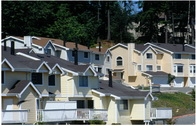Advertisement
HUD Reports 20 Percent Rise in Worst Case Needs From 2007-2009

In a report to Congress, the U.S. Department of Housing & Urban Development (HUD) found that “worst case housing needs” grew by nearly 1.2 million households, or more than 20 percent, from 2007 to 2009 and by 42 percent since 2001. “Worst case housing needs” are defined as low-income households who paid more than half their monthly income for rent, lived in severely substandard housing, or both.
HUD’s study, "Worst Case Housing Needs 2009: A Report to Congress," one in a long-term series of reports designed to measure the scale of critical housing problems facing low-income unassisted American renting households. The findings are based on data from the joint HUD/U.S Census Bureau’s American Housing Survey conducted between May and September of 2009, predating the impact of the Obama Administration’s economic recovery efforts, including the American Recovery and Reinvestment Act (ARRA). This report finds a direct link between the increased numbers of worst case needs and the recent recession and related joblessness.
“These numbers show the scale of the challenge inherited by the Obama Administration, with a historic increase in need during the two years before we took office,” said HUD Secretary Shaun Donovan. “The report shows a clear link between unemployment and housing needs and that’s why the President has been so focused on creating jobs. A growing economy and new jobs, combined with HUD’s new commitments to produce and preserve affordable rental housing is what we need to reverse this trend.”
Dr. Raphael Bostic, HUD’s Assistant Secretary for Policy Development and Research, said, “The loss of income and the general lack of affordable housing are clearly putting a lot of stress on unassisted families at the lower end of the income spectrum. It’s equally clear that had it not been for housing assistance offered by HUD, the economic impact on very low-income renters would have been greater still.”
These worst case housing needs are defined as renters with very low incomes (below half the median in their area) who do not receive government housing assistance and who either paid more than half their monthly incomes for rent, lived in severely substandard conditions, or both. HUD’s report finds that needs cut across all regions of the country and included all racial and ethnic groups, regardless of whether they lived in cities, suburbs or rural areas. In addition, HUD concluded that large numbers of worst case needs were also found across various family types including families with children, senior citizens, and persons with disabilities.
The increase in the extent of worst case housing needs represents the largest two-year jump since HUD began reporting this segment of the rental market in 1985. Unemployment and under-employment pushed 410,000 more households into the worst case needs category accounting for more than one-third of all new cases.
HUD’s report found:
►Worst case housing needs were 7.10 million in 2009 (41 percent of very low-income renters), up from 5.91 million (37 percent). This represents more than a 20 percent increase from the number of worst case needs in 2007.
►Every racial/ethnic group experienced increases in worst case housing needs during 2007-2009 with Hispanic households having the largest increase in incidence (eight percentage points).
►Higher income families are competing for a limited number of affordable rental units further driving down already-low vacancy rates for the lowest rent units. Only 36 of every 100 extremely low-income renters have affordable units available to them.
►Dramatic increases in worst case needs were caused by shrinking incomes as well as rent increases due to increased competition among low-income families for fewer affordable units.
►Worst case needs among renters with disabilities increased from 37.5 percent to 40.7 percent (of all very low-income renters with disabilities).
►The availability of affordable rental housing varies across regions of the country with supply most scarce in the West, where only 53 units available per 100 very low-income renter households, compared with 65 in the South, 66 in the Northeast and 87 in the Midwest.
Government housing assistance programs, including those provided by HUD, significantly reduce worst case needs and homelessness but are not available for all those who need assistance. Nationwide, 25 percent of the very poor receive some form of rental assistance.
The Obama Administration has been taking strong action to respond to the decline in family incomes and increase in need for affordable housing:
►Recovery Act: Nearly 341,000 units of affordable housing are rehabilitated or constructed through the Recovery Act’s Tax Credit Assistance Program and Public Housing Capital Fund. In addition, the Recovery Act guaranteed rental subsidy to approximately 1.2 million units of affordable housing through HUD’s Project-based Rental Assistance Program. Meanwhile, the Recovery Act’s Homeless Prevention and Rapid Re-housing Program prevented or ended homelessness for more than 750,000 persons.
►Opening Doors: In June, the U.S. Interagency Council on Homelessness (USICH) unveiled Opening Doors, the nation’s first comprehensive strategy to prevent and end homelessness. The plan puts the country on a path to end veteran and chronic homelessness by 2015; and to ending homelessness among children, family, and youth by 2020.
►National Housing Trust Fund: The Obama Administration is seeking $1 billion to invest in thousands of new affordable housing units targeted to the nation’s lowest income families.
►Transforming Rental Assistance: Over the last 15 years, the country lost 150,000 units from its public housing stock through sale or demolition and many of the nation’s public housing apartments are buckling under a $20 to $30 billion backlog in capital needs. Under the Administration’s comprehensive strategy to preserve and enhance the country’s affordable housing stock, HUD would allow public housing owners’ access to safe, reliable public and private funding to renovate their properties—unlocking an estimated $7 billion the first year and as much as $25 billion in the years to come.
Click here to read the 2009 Worst Case Housing Needs Report to Congress.
For more information, visit www.hud.gov.
About the author





